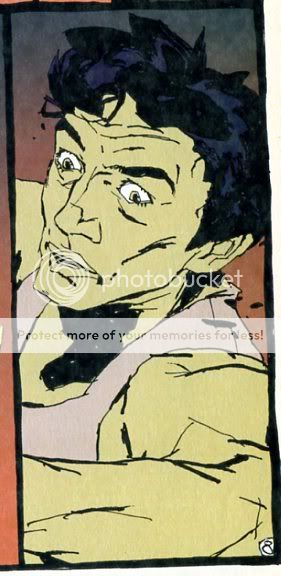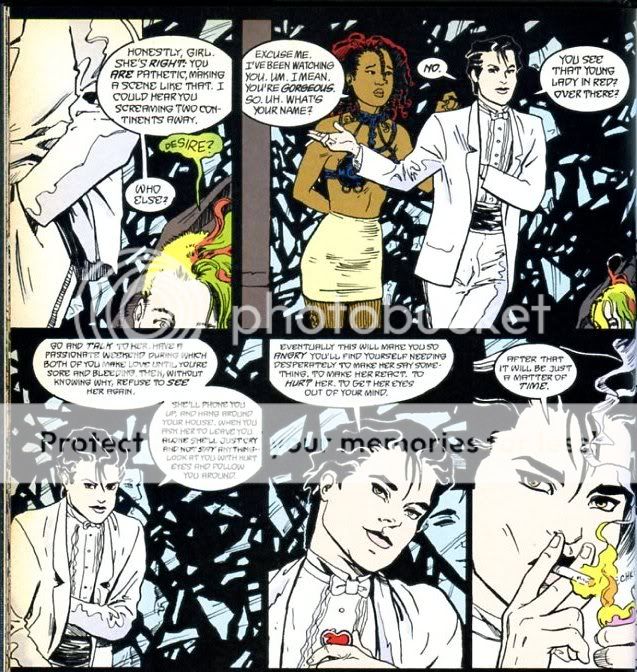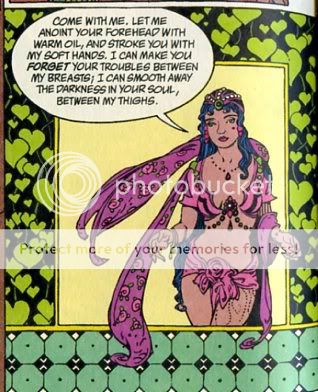This is the first in a roundtable on Neil Gaiman’s Sandman series. Suat, Tom, Vom Marlowe, and Kinukitty will be along later in the week with their takes on the series as well. (Update: And you can now read the complete roundtable)
______________________
I loved Sandman back when it came out in the late 80s/early 90s, and I’ve probably read the whole thing through at least a couple of times. However, it’s been a while…partially out of nervousness. I strongly suspected that the epic wouldn’t hold up on rereading.
And…yeah. It doesn’t exactly hold up. I reread the entirety of “Fables and Reflections” and skimmed through a couple of the other books (“A Game of You” and “The Kindly Ones” especially, I think.) Part of it is the art, which bounces around inconsistently and is often just not especially good. There are undoubtedly some very nice walk-ons — Bryan Talbot’s creepy take on the giant, cadaverous Persephone was memorable, and, as Suat recently pointed out, the P. Craig Russell “Ramadan” story is pretty spectacular. But then you’ve got atrocious efforts by folks like Kent Williams.
No wonder he looks startled; he appears to be improbably made out of rock. Maybe he’s related to the Thing?
Aside from the inconsistencies in the art, though, the real problem is that my former enthusiasm for Gaiman’s writing has dimmed a lot. I can still appreciate his cleverness and the care of construction…but after a while, both of those virtues are pushed so enthusiastically and unilaterally that they start to feel oppressive. After a while you start to almost want to plead — please, somebody, anybody, could you just once say something that doesn’t come back a panel, or a page, or several issues down the road with an ironically profound or profoundly ironic twist? Could we have a story end without a smug little O’Henry meets dumbed-down Borges twist? Could everybody just for a fucking second stop talking?
The thing that crystallized my irritation with the series was Nuala. She was a fairy with a glamor that made her appear as a beautiful woman, but in actuality she was kind of a dumpy elvish little thing. The fairy gave her as a gift to Dream for some reason or other (maybe to try to get him to give them the key to hell? I can’t remember exactly.) Anyway, she fell in unrequited love with dream, and ends up nervously and apologetically causing his downfall. She’s a sad, sweet character. I liked her.
But as I was sort of skimming over her story again it occurred to me that, while her unrequited love is certainly poignant, it’s also weirdly unmotivated. That is, we certainly do feel her pain and sadness to some extent…but we never really get much of a sense of her love. What about him appeals to her? Does she think he’s beautiful? Is it his (on again off again) kindness to her? His power? There don’t have to be individual or even clear answers to these questions, obviously, but they’re never even asked, much less answered. For Gaiman, Nuala’s love is an almost magical fact; it drops onto her and possesses her, and that’s all we ever really need to know about it.
And that’s how love functions throughout the story. Gaiman almost never, that I can remember, actually bothers to show love as a functional, or even dysfunctional, relationship between two people. Instead, it’s just another plot device, a story element to push the action…or, more accurately, the words. In “A Game of You” the cuckoo casts a love spell by talking; in “Brief Lives” Desire does more or less the same thing.
That seems to be how Gaiman sees love; a verbal whammy that comes out of nowhere to make a clever point or set up a clever scene, rather than as an actual relationship which is maybe worth exploring in its own right. Destruction accuses Orpheus of loving the idea of Eurydice more than the actual person…but is that really Orpheus’ failing? Or is it Gaiman’s? Certainly, Gaiman never shows the couple in a tender moment — Eurydice gets more time with a Satyr in the narrative than she does with her supposed love. And the big love affair of the book, between Dream and Thessally, occurs almost entirely off-screen..ostensibly because doing it that way is clever and surprising, but maybe actually because Gaiman has no idea how to deal with an actual love affair and is scared shitless to try. Certainly, the hints of the romance we get sound deeply unconvincing — when they’re in love they walk about idyllically among the bowers prattling sweet nothings, making some of Dream’s attendants uncomfortable; when theyr’e out of love it rains a lot because Dream is throwing a tantrum. Gaiman is clear that these are cliches, and he’s making fun of them because they’re cliches…but that doesn’t change the fact that he doesn’t seem able to deal with love in anything but cliches.
There’s actually an analogy here with another, more recent tween phenomena: Twilight. In both, there’s a lot of darkness and angst, which gives an exciting frisson of danger even as it distracts from the things that an actual adolescent might really find dangerous or threatening. In Twilight, the danger of vampires and blood and werewolves and melodrama all stands in for, and obscures, the looming, oncoming reality of adult relationships and sexuality. In Sandman, similarly, the pretension and the cleverness and the angsty melodrama seems, at some points, like a magician’s trick; the left hand is bobbing and weaving and throwing out fireworks so that you don’t notice (except with a kind of unacknowledged satisfaction perhaps) that there’s not much at stake in the right.
Though that all sounds kind of harsh, I’m actually not against this kind of tween repression categorically; in the Twilight series ( which I’ve mentioned liking before) I think the sustained effort to avoid looking at the obvious ends up energizing the series; it’s both winning and squicky, a kind of pop sublime. In Sandman I’m not sure it works so well. On the one hand, Gaiman is in some sense obviously a better writer than Stephanie Meyer. Though, as I said, the cleverness is irritating, it is, nonetheless, often actually clever, and he does manage to come up with some genuinely creepy twists (the treacherous stuffed toys in “A Game of You”) as well as some moving ones (Nuala’s story for example, as I mentioned above.) Meyer is not as bad as she’s sometimes claimed to be, but I doubt she could have pulled off either of those things.
On the other hand…Sandman is way more pretentious than Twilight…and the distance between the pretensions and the delivery is sometimes painful. For instance, there’s this panel:
Ah, those harem maidens…so exotic! So poetic! So unaccountably possessed of the sweaty metaphorical unease of a randy 13-year old trying to look impressively sophisticated!
It’s significant too, I think, that the so-thoughtfully entreated king declines the request. In Twilight, the heroine and hero eventually do, in fact, after much deferral (and marriage) have sex. This is in itself problematic; the whole tension of the series rests on the balance between safety and desire which is more or less vitiated when everybody gets what they desire and ends up safe. Gaiman is more canny; Dream, elaborately and with much fanfare, refuses to alter the structure of the series. Rather than change he decides to kill himself. Gaiman makes the “change” in question specifically about responsibility; Dream is not willing to give up his duties as ruler of dream, and so his only way out is death. But one has to wonder — is it really his (quite amorphous) duties that are at stake? Or is it something else? His ex-lover and Nuala more or less engineer his final downfall, his realm is torn apart by the furies, a rampaging feminine archetype — and the way they taunt him at the end is borderline sensual. “We are destroying the dreaming. Can you not feel it?” “Yes I can.” But then interrupts the foreplay, and Dream scurries off into oblivion, leaving one more fraught relationship we don’t get to really explore. Like a cadaverous Peter Pan, he never grows up, never has to stay with Wendy, and never gets out of the dream.
_______________
Update: Suat’s post is now up.
Update: Vom Marlowe and Tom weigh in.
Update: And Kinukitty finishes up.



